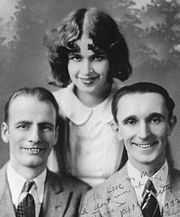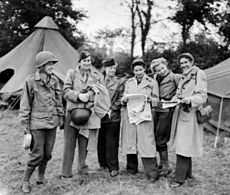Wilson, Keppel and Betty
| Wilson, Keppel and Betty | |
|---|---|
 Eccentric dance act | |
| Born |
Jack Wilson Joe Keppel Betty Knox Patsy (Betty's daughter) |
| Known for | Music hall sand dance |
Wilson, Keppel and Betty formed a popular British music hall act in the middle decades of the 20th century. They capitalised on the fashion for Ancient Egyptian imagery following the discovery of the tomb of Tutankhamun. The "sand dance" that formed the highlight of their act was a parody of postures from Egyptian tomb paintings, combined with references to Arabic costume. The lithe and extremely lanky Wilson and Keppel, who wore long moustaches and make-up to emphasise the sharp angularity of the features and make them appear almost identical, demonstrated their impressive suppleness in adopting wild gestures and dancing in identical "stereo" movements, while Betty watched their antics. The dance itself was a soft-shoe routine performed on a layer of sand spread on the stage to create a rhythmic scratching with their shuffling feet. The act was usually performed to the familiar Egyptian Ballet (1875), by Alexandre Luigini.
Early careers

Jack Wilson (29 January 1894–24 August 1970), was born in Liverpool in England, and emigrated to the USA at a young age, making his stage debut in 1909 as a high-kicking dancer. He then travelled to Australia, where he joined Colleano's Circus. During the First World War Wilson served with the Royal Navy.
Returning to Australia after the war, he met Joe Keppel (5 May 1894–14 June 1977), who was born in County Cork in Ireland. Like Wilson, Keppel had emigrated to the USA at a young age, and in 1910 made his stage debut in Albany as a tap dancer. During the First World War he served in the Royal Flying Corps, and after making his way to Australia, also joining Colleano's Circus, where he teamed up with Jack Wilson.[1]
International celebrity
Travelling to the USA together they appeared in New York in 1919 as a comedy acrobatic and tap dancing act. They started their trio act with Kansas-born Betty Knox (Alice Elizabeth Peden - (1906-1963)), at Des Moines in Iowa in 1928. She had married mechanic Donald Knox in 1923 and after a brief marriage went on to be a chorus girl in a production which also featured a young Jack Benny.[2]

The act came to Britain to appear at the London Palladium for a few weeks in 1932 and stayed permanently. Over the years there were between 8 and 12 'Bettys', most of these appearing during the act's later years: Betty Knox retired from the act in 1941 to go into journalism, becoming a war correspondent during the Second World War,[3] and reporting on the Nuremberg Trials for three years as a correspondent for the London Evening Standard.[4] She was among the first to report the suicide of Hermann Göring[5]
Her daughter, Patsy Knox, (born 1924 in Salina, Kansas), took over as 'Betty' in 1941, staying with the act until 1950. The trio, in its various line-ups, appeared at the Royal Variety Performance in 1933,[6] 1945 and 1947.

Their "Cleopatra's Nightmare" routine was performed in 1936 in Berlin and condemned by Joseph Goebbels as indecent.[7] In the UK they were regarded as one of the best 'speciality acts' – acts designed to balance and support the star of a variety programme. Typically these acts would last about ten minutes, and be repeated twelve times a week (matinee and evening performance, every day except Sunday) in variety theatres all over the country. A fine example of the "Cleopatra's Nightmare" routine can be seen in the Harold Baim film 'Starlight Serenade".
In 1950 they appeared at the London Palladium on the same bill as Frank Sinatra. They toured all over the world, performing at shows in London, Europe, Las Vegas, India, the Far East and Near East, Australia, Scandinavia and South Africa. They finally retired in 1962 after a performance in Great Yarmouth.[8] Betty Knox died in 1963 at her home in Dusseldorf in Germany, where she had lived since the end of World War II.[2]
George Melly, the celebrated jazz vocalist is quoted in his biography as saying "There were several Bettys, they would get rid of one after about 10 years. I knew the last Betty, her son was a brilliant female impersonator...." In addition to Betty and Patsy Knox, the other Bettys included Edna May Lark (who once stood-in in for Patsy Knox), Irene Edwin-Scott, Barbara Holt, Mary Wemys (who appeared in the act in Las Vegas), Maureen Drew (the first Betty to appear on television), Valerie Cottrell, Jean Bamberger, and Jean McKinnon, the last Betty when the act broke up in 1962.
Jack Wilson moved into Brinsworth House, a retirement home for showbusiness personalities, where he died in 1970, while Joe Keppel died in St Finbars Hospital in his native Cork in Ireland in 1977.[2]
A pop art sculpture of the trio, The Sand Dancers made by Nicholas Monro for the Sands Hotel, Edinburgh, is now part of the Treadwell Collection.[9]
References
- ↑ Luke McKernan (2007). "The Wilson, Keppel and Betty Story".
- ↑ 2.0 2.1 2.2 'Wilson, Keppel and Betty - Curios' - That's Entertainment website
- ↑ "glbtq >> arts >> Mann, Erika". Google cache. Retrieved 2013-10-02.
- ↑ "The Nuremberg Judgments". Google cache. Retrieved 2013-10-02.
- ↑ "The Press: Vigil in Nurnberg". Time (New York). 28 October 1946.
- ↑ Wilson, Keppel and Betty at the London Palladium in 1933 - The Royal Variety Performance website
- ↑ Ronnie Bray (March 2007). "Herr Göbbels Flunks The Ballet Egyptien Test". Open Writing.
- ↑ 'Kindly Leave the Stage – a history of Variety, 1919 – 1960', by Roger Wilmut (ISBN 0-413-48960-4)
- ↑ "Nicholas Monro | Treadwells". Retrieved 22 August 2011.
External links
- Wilson, Keppel and Betty at the Internet Movie Database
- Video of a 1933 performance at the Trocadero restaurant in London
- YouTube snippet of the Sand Dance.